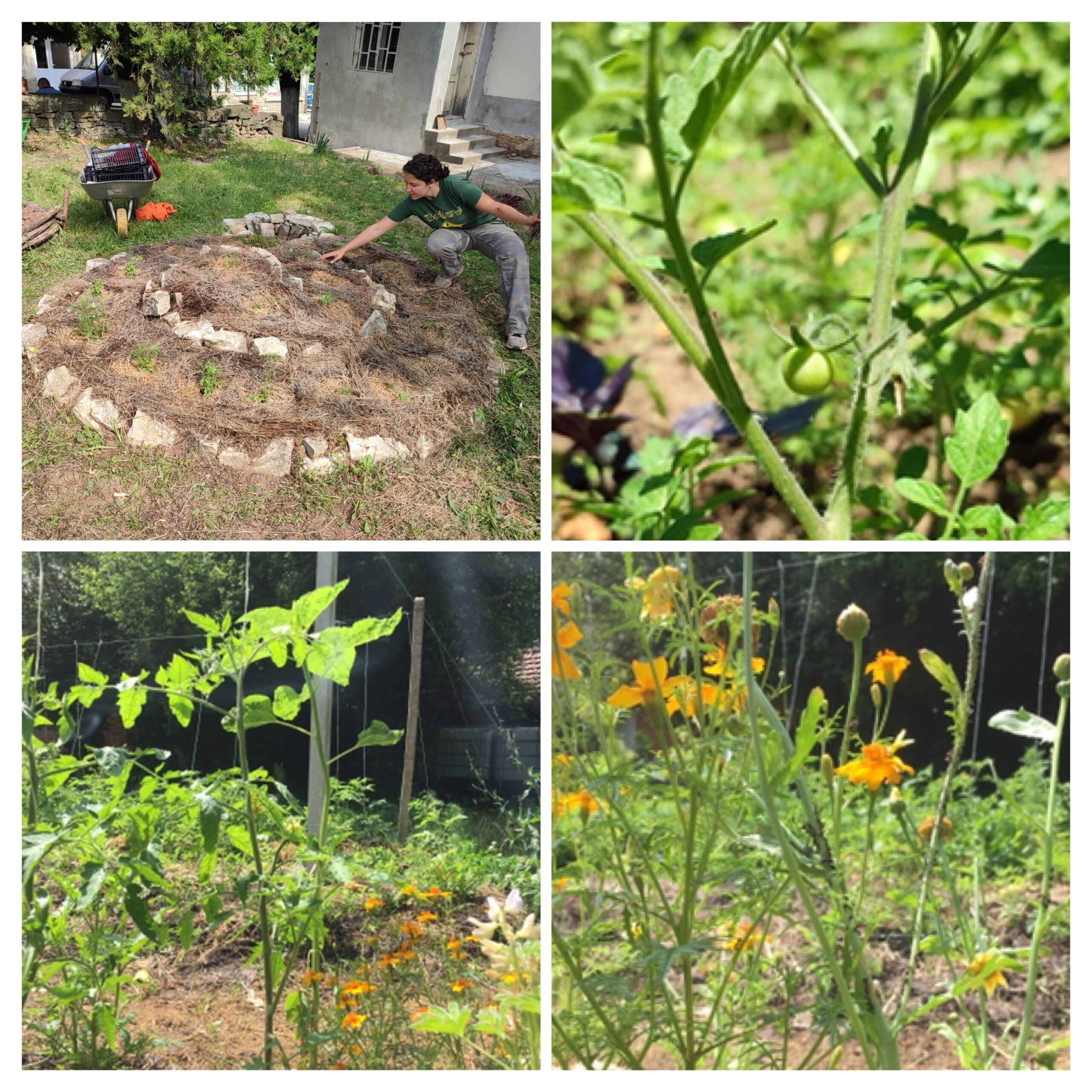Anastasja:
Hey y’all,
For this week’s blog post, you will forgive me, as I’m about to cover two weeks in one since nothing much happened last week. We only came back from the festival on Tuesday, took Wednesday off, and struggled with some post-festival sickness towards the end of the week. This week, on the other hand, we had quite some activities on our plate.
On Monday… drum roll… we finalized the herb spiral! We had waited for the soil to set, and already saw some weeds growing, so we decided it was time to proceed with the final stages of the process: planting and mulching. But before you can plant, of course, you have to weed. Luckily, a very nice employee of the municipality, Maria (also called Matza), helped us with the weeding.
Then, we planted seedlings of whatever we could spare from the gardens. At the bottom of the spiral we interplanted moisture and shade loving comfrey and sorrel. From the top down, there’s rosemary, lavender, sage, thyme, nasturtium, and hyssop. On the west and south side there are sun-loving flowers like tagetes, camomile, and pea vetch (vicia pisiformis), and some basil on the east side. We decided to plant some flowers together with the herbs, to attract beneficial insects, and because we noticed in the past months that the locals like flowers a lot. Then we mulched the spiral, a process which Maria found surprising, but after explaining it (in very basic Bulgarian) she seemed convinced of the idea.
In the next few days it rained a lot (and there’s more rain to come), so it seems like our timing was perfect, and the plants are looking very well established. We’re proud of the result, and hope the locals will enjoy it too, also by adding their own plants and making the spiral their own.
UP LEFT: Herb spiral final touches (photo credit: Peter Spornberger). UP RIGHT: First little tomato (photo credit: Vyara Marinova). DOWN LEFT: Young tomato growing next to tagetes DOWN RIGHT: Tagetes attracting lice which are being eaten by ants (photo credit: Anastasja Giacomuzzi).
Of course, we also planted a lot in Venets’ gardens. Among other things, some Malabar spinach, basil, and okra (which we grew from seeds we got at the seed festival in Elin Pelin) have found their spots in the Red house garden. Besides planting, there is also constant maintenance to do. For instance, we made structures for the cucumbers and tomatoes to grow on.
Another activity which keeps us busy is looking after the tomatoes. Every few days we grow through the rows, pinch, bind, and roll tomatoes up on their strings. Why all this effort? Can’t you just let the tomatoes grow free and wild? Yes, you can. For example, the waterless tomatoes we planted in Suhidol have a lot of space to grow, and will eventually grow in all directions on the ground. However, for the tomatoes in the gardens there is less space, and we want them to be as productive as possible in as little space as possible.
This means, first of all, that we pinch the tomatoes in the gardens. Pinching means to take out the leaves which grow out of the “armpits” of the tomatoes. The armpits are in between the so-called “sunleaves” on the sides and the stems. The leaves that grow in the armpits are called “suckers” because they suck energy from the plant, but because they grow in between the other leaves where it is more shady, they don’t give much energy back to the plant. Moreover, if the suckers grow bigger, they make the sunleaves grow downwards to the ground. This way, the plant will branch out along the ground, something we don’t want in a garden where space is an issue. In addition, the energy which the suckers take from the plant, also means that energy is distributed more, and not concentrated on fruit growth; which means more leaves – less tomatoes. By pinching out the suckers, we also allow for more air to flow through the plant, minimizing the risk of some diseases.
Once the plants are bigger, we will also prune out the lower layer of the leaves which are closer to the ground. This will also increase airflow, and avoid diseases from the ground. Additionally, this will allow us to interplant the tomatoes with other plants, such as basil and flowers. It’s a great idea (which we learned from our supervisor Vyara) to plant flowers close to tomatoes and other veggie plants. The flowers not only attract pollinators and other beneficial insects. They also attract aphids, lice, and other bugs we don’t want on our tomato plants! You can really observe in our gardens (see pictures), that these pests are concentrated on the flowers, even if the tomatoes are close by. Then, little helpers like ants and ladybugs find these concentrations of bugs, and feast on them, leaving the tomatoes and flowers happy and healthy.
Happy tomato pruning (or not),
Anastasja



